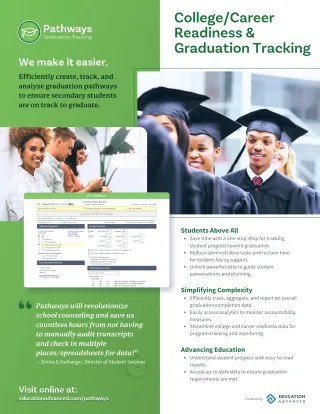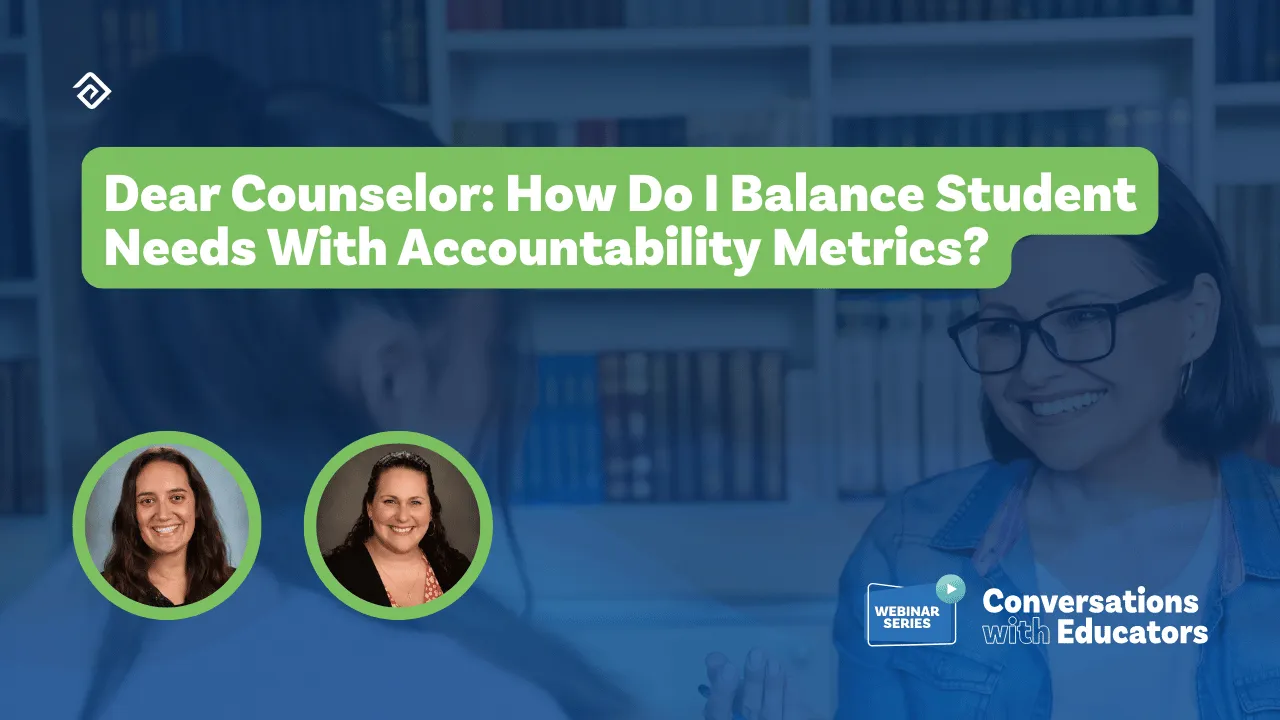Student-to-Counselor Ratio: Striking the Right Balance for Student Support

Student-to-counselor ratio refers to the number of students assigned to each school counselor. The American School Counselor Association (ASCA) recommends 250 students per school counselor (250:1). This ratio allows the implementation of compressive school counseling programs so that counselors can effectively deliver developmentally appropriate services and meet the academic, career, and personal/social support needs of students.
While counselors are essential to the school’s support system, a high or unbalanced student-to-counselor ratio can make it difficult for these professionals to lead, advocate, and collaborate with other key stakeholders to ensure positive student outcomes.

Counselors wear MANY hats...
- social/emotional services
- crisis counseling
- college and career planning
- monitoring of students’ academic performance and accountability
- transcript, testing, and graduation review
- special-population and underrepresented student support
- course selection scheduling responsibilities
- managing Individual Education Plans for 504 and/or Special Education students
The higher the case load, the less individualized time counselors have for each student and the more counselors have to spread themselves too thin to meet students’ needs. This leads to ineffective and incomplete counseling services.
It is therefore highly important for districts to achieve and maintain the recommended appropriate and manageable student-to-counselor ratio for increased efficiency in serving all students.
Current Student-to-Counselor Ratios and Factors Influencing the Trend
Recent data from ASCA covering the 2021-2022 school year puts the national average ratio of student-to-counselor at 408:1. This figure is by far the lowest ratio since 1986 when the ASCA began monitoring these ratios across the United States.
From 1986 to 2020, schools nationwide witnessed a gradual closing of the margin in the student-to-counselor ratio, especially since 2013. During this period, the ratio steadily decreased each consecutive year, progressing from 491:1 to its current state.
ASCA’s efforts in redefining the role of counselors over the years, as well as shifting public opinion, are important factors influencing the gradual decrease in the ratio of students per counselor. Additionally, the pandemic helped spotlight the increasing mental health crisis among young people, leading to increased funding for school districts to meet students’ social-emotional needs.
Recently, the National Education Association (NEA) summarized federal grant programs catering to school-based mental health services. Funding, especially at the national level, is key to lowering caseloads as more money is available to hire school counselors, social workers, and psychologists.
While this trend is certainly in the right direction, 408 students to one school counselor is still a long way from ASCA’s recommendation of 250:1. Many schools across the nation still have to deal with high caseloads, and counseling can become particularly overwhelming for professionals working in high schools without the right tools to make their work effective.

Impact of High Caseloads on Counseling
One of the most important responsibilities of a counselor is helping a child plan for postsecondary success by helping him or her choose a college or career path; however, the support of students’ social-emotional well-being is at the forefront of counselors’ daily work for all grade levels, K-12. However, high caseloads can prevent students from accessing this all-important benefit, and regardless of a counselor’s commitment to helping young people, there is only so much even the most efficient and professional individual counselors can do under excessively high caseloads.
Inflated caseloads often translate to:
- Increased workload and stress for school counselors and reducing job satisfaction.
- Limited time to dedicate to each student leading to reduced individual attention.
- Higher risk of students falling through the cracks, especially for those with learning disabilities, behavioral issues, and those from disadvantaged backgrounds.
- Reduced access to counseling and support for students dealing with emotional or psychological challenges.
Why the Student-to-Counselor Ratio Matters
The student-to-counselor ratio is critical in ensuring effective student support and well-being. Research suggests that schools with lower student-to-counselor ratios tend to have fewer disciplinary problems and better student outcomes. Interestingly, these results are especially true for minority students and those from low-income families.
Striking the right balance of student-to-counselor ratio matters:
Individualized Attention
A balanced ratio allows counselors to provide more personalized attention to each student. With fewer students to handle, counselors can spend more time understanding their unique needs, offering guidance, and developing tailored plans for academic and personal growth.
Academic Success
Students who receive adequate support from counselors have a higher chance of getting better grades and excelling academically. Counselors can assist with course selection, academic planning, and addressing learning challenges. In addition, they play an important role in college and career choices, helping students explore options, navigate the application process, and make informed decisions.
Social and Emotional Support
Social and emotional challenges can impact students’ academic performance and overall well-being. A lower student-to-counselor ratio allows counselors to provide appropriate emotional support to students and address their mental health concerns. It also enables counselors to properly guide students through social difficulties, creating a positive and inclusive school environment.
Early Intervention
Identifying and addressing issues early are crucial for student success. With a balanced ratio, counselors have the capacity to identify signs of academic struggles, behavioral issues, or mental health concerns at an early stage. Timely intervention and appropriate support can potentially prevent such problems from escalating.
College and Career Readiness
College and career planning can be overwhelming for students. Counselors play a key role in guiding students through this process, assisting with college applications, scholarship opportunities, and career exploration. Students in schools with a relatively low student-to-counselor ratio are more likely to receive the necessary guidance and support to make informed decisions about their future.
Equity and Access
In schools with high student-to-counselor ratios, certain groups of students may face barriers to receiving adequate support. Students with special needs, those who require additional assistance, and those from disadvantaged backgrounds may be disproportionately affected. Striving for a balanced ratio helps ensure equitable access to counseling services for all students.
Student Well-Being
The presence of counselors and a favorable student-to-counselor ratio contributes to students’ overall well-being. With lower caseloads, school counselors can better carry out their essential roles, which among other things, include:
- Promoting positive mental health
- Supporting social-emotional development
- Providing resources for coping with stress and challenges
These functions can foster a healthier and more supportive learning environment leading to positive student outcomes.
Maintaining an appropriate student-to-counselor ratio is crucial for promoting academic success, addressing social-emotional needs, and ensuring equitable access to resources for all students.
However, the current student-to-counselor ratio of 408:1 still significantly exceeds the ASCA’s recommended ratio of 250:1. This indicates that students are underserved because school counselors are spread too thin and often encounter overwhelming caseloads.
As school systems continue to face these challenges, educational leaders can take immediate steps to create better processes and procedures utilizing innovative technology to help streamline some of the demands counselors have to manage.
College and career readiness tools like Pathways can help school counselors reduce the volume of manual work they do, giving back invaluable time while ensuring accuracy and efficiency. A district’s implementation of educational tools like Pathways enables the focus to be on fostering valuable relationships with students while supporting their specific academic and social-emotional needs and ensuring high school students are on track to graduate.
If your school is interested in new ways to improve the learning experience for children, you may also be interested in automating tasks and streamlining processes so that your teachers have more time to teach and administrators have more time to focus on supporting effective instruction. Education Advanced Inc. offers a large suite of tools that streamline processes and procedures, save significant time and money, increase accuracy, create common language and practice, and promote positive school culture. Some of our most popular and effective tools are:
- TestHound, our test accommodation software, helps schools coordinate thousands of students across all state and local K-12 school assessments while helping to track and manage accommodations (reading disabilities, physical disabilities, translations, etc.) with accuracy and ease for students.
- Pathways, our college and career readiness software, helps administrators and counselors create, track, and analyze graduation pathways to ensure secondary students are on track to graduate.
- Evaluation, our teacher evaluation software, documents every step of the staff evaluation process, including walk-throughs, self-evaluations, supporting evidence, reporting, and performance analytics.

More Great Content
We know you'll love




